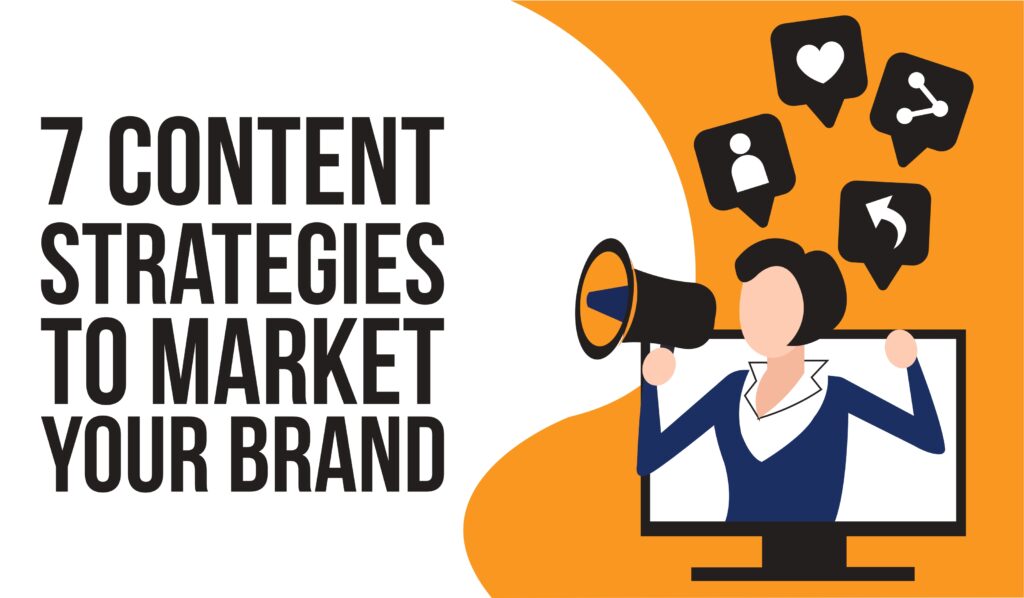
Content marketing is one of the best ways to grow your business, especially if you are a startup. It’s one of the most cost-effective and easiest ways to market your business or organization. However, many companies don’t know how to use content marketing to grow a business and get a higher conversion rate. Small businesses now realize the potential of content and how marketing it can help them grow their businesses. It comes from using the right tools and knowing what you are doing. Here are some tips on making the most of content marketing to grow your business.
What Is Content Marketing?

By continually producing and curating pertinent and valuable material to alter or improve consumer behavior, content marketing tries to draw in and keep customers. Encouraging observed consumer behavior is its ultimate objective.
To draw in and keep the attention of a target audience and, eventually, to encourage lucrative consumer action, content marketing is a strategic strategy that focuses on producing and disseminating valuable, pertinent, and consistent material.
Four categories are used in content creation and marketing: attraction, authority, affinity, and action.
- Attraction content is designed to attract new customers and prospects to your business. It typically includes information about your products or services and your company’s brand and identity.
- Authority content is designed to establish your business as a thought leader in your industry. It typically includes expert opinions, original research, and in-depth analysis.
- Affinity content is designed to build relationships with your existing customers and followers. It typically includes social media content, blog posts, and email newsletters.
- Action content is designed to prompt your audience to take a specific action, such as subscribing to your email list, following you on social media, or making a purchase. It typically includes calls-to-action, coupons, and special offers.
Through content marketing, businesses can educate and inform their target audiences about their industry, products, or services excitingly and helpfully. By providing relevant and valuable content, companies can build trust and credibility with their target audiences, increasing brand awareness and preference and, ultimately, more sales and revenue.
7 Content Strategies To Market Your Brand

Content strategies for marketing encompass a wide range of activities, all aimed at creating and distributing content that will attract and engage customers. Typically, a content strategy will involve developing a content calendar, identifying the content types, and deciding who will create it. It may also include creating guidelines for how the content should be made, distributed, and measured for success.
While the specifics of a content strategy will vary from business to business, there are some commonalities. A content strategy should always be aligned with business goals and consider the needs and preferences of the target audience. Creating engaging and valuable content is the key to success, so a content strategy should always focus on creating interesting, informative, and relevant content for the target audience.
1. Identify Your Target Audience
Several content strategies can be used to market your brand, but one of the most important is identifying your target audience. Once you know your target audience, you can create content specifically designed to appeal to them. Videos, infographics, blog entries, and social media posts may all fall under this category. By creating content targeted at your target audience, you can more effectively market your brand and reach your desired customers or clients.
2. Carry Out Keyword Research
One of the most critical aspects of marketing your brand online is to carry out keyword research. This will help you identify the terms and phrases potential customers use to search for products or services like yours. Once you know which keywords to target, you can integrate them into your website content, blog posts, social media campaigns, and other marketing materials. This will help ensure that your brand is visible to people searching for what you have to offer.
Keyword research can be complex and time-consuming, but it is essential for success in online marketing. Several tools and resources are available to help you carry out keyword research, so it is worth taking the time to familiarize yourself with them. Once you have a list of target keywords, you can implement them into your marketing strategy. With a little effort, you can ensure that your brand is visible to those most likely interested in your offer.
3. Identify And Allocate Resources
There are several content strategies you can use to market your brand. The first step is identifying which platforms and channels work best for you. Once you’ve done that, you need to allocate the necessary resources (time, money, and people) to make it happen.
One popular content strategy is to create a blog and post regular content. This is a great way to build a following of interested readers who will engage with your brand. Another strategy is using social media platforms to reach potential customers. Paid advertisements, organic posts, or a combination can accomplish this.
Whatever strategy you choose, the important thing is to be consistent and put in the effort to make it work. With the right approach, you can use the content for marketing your brand and reaching your target audience effectively.
4. Create A Content Calendar
A content calendar is a tool that will help you plan, organize, and execute your content marketing strategy. It will provide a framework for creating and publishing content aligned with your business goals. And it will help you to measure the success of your content marketing efforts.
Although creating a content calendar might appear difficult, it need not be. Start by thinking about the types of content you want to make and the topics you want to cover. Then, determine the frequency with which you want to publish new content. Once you have a general idea of what you want to achieve, you can fill in the details.
Several content calendar templates are available online if you need help figuring out where to start. Or, you can create your own using a spreadsheet or word processing program. Whatever approach you choose, make sure to include the following information in your content calendar:
- The type of content you will create (e.g., blog post, video, infographics)
- The topic of the content
- The target audience for the content
- The date the content will be published
- The channels you will use to promote the content (e.g., social media, email marketing)
By planning and organizing your content marketing efforts, you can achieve your business goals better. And you’ll be able to save yourself a lot of time and effort in the long run.
5. Create Content
Creating high-quality, engaging content is a great way to get people interested in your brand. You can also use content to build relationships with potential and current customers. Creating helpful, informative content can help you establish yourself as a thought leader in your industry.
You can also use content to drive traffic to your website or blog. Creating a mix of different types of content (e.g., blog posts, infographics, videos, etc.) can help you reach a wider audience and keep people engaged with your brand.
6. Promote Content To Your Target Market
You can use several content strategies to market your brand and promote your content to your target market. One popular method is creating a blog post or article targeting your target market. This can be an effective way to reach out to potential customers and get them interested in your product or service.
Another content strategy is creating a social media campaign targeting your target market. Finally, you can also use email marketing to reach potential customers and promote your product or service. Both these can be effective ways to reach out to potential customers and get them interested in your product or service.
7. Measure Results
Several content strategies can be used to market your brand, but measuring the results is essential, so you know what’s working and what isn’t. One way to do this is to track your website traffic and see how much traffic is coming from your content.
You can also track engagement by looking at comments, social shares, and email subscribers. You can also track those metrics if you have a specific goal, like generating leads or making sales. By measuring your results, you can adjust your content strategy accordingly and ensure that your efforts are working to achieve your desired goals.
What’s The Importance Of Content Optimization?

Content optimization is making your content as effective as possible in achieving your business goals. This includes ensuring that your content is well-written, relevant to your target audience, and optimally placed for maximum visibility and engagement.
There are many benefits to content optimization. The most obvious is that it can help to improve your bottom line by driving more traffic and engagement. But it can also help to build your brand and reputation and to establish you as a thought leader in your industry.
Content optimization is an ongoing process, and it’s essential to constantly monitor and adjust your strategy to ensure that your content is still achieving your desired results. But the effort is well worth it, as content optimization can effectively grow your business.
Different Ways To Optimize Your Content
There are several ways to optimize your content to ensure it is as effective as possible. One of the most important things to do is to target your keywords effectively, both in terms of the overall focus of your content and the individual keywords you use.
Additionally, you must ensure that your content is well-written and engaging, as this will help to keep readers interested. Finally, you should promote your content through social media and other channels to reach as many people as possible.
6 Basic Content Types

To effectively reach your ideal audience, you must ensure your content strategy includes all six types of content. By doing so, you’ll be able to capture your audience members’ attention and keep them engaged with your brand.
1. Blog Posts
Blog posts are one of the most shared content types on the web. They are typically short pieces of writing published on a website or blog and can be about anything from personal thoughts and experiences to news and current affairs.
Blog posts are usually written in a more informal style than other types of content and are often personal and opinionated. This makes them great for connecting with readers and building a following.
2. Guest-Contributed Articles And Syndicated Content
Three primary types of content can be published on a website: original content, guest-contributed articles, and syndicated content. Each has its benefits and drawbacks, so it’s essential to understand the difference before deciding what content to publish.
Original content is created by the website’s staff and is exclusive to the site. This content can effectively drive traffic and engagement, but it can be expensive and time-consuming.
Guest-contributed articles are written by people who are not affiliated with the website. These articles are often less expensive and time-consuming to produce than original content, but they may need to be more effective in driving traffic and engagement.
Syndicated content is content that is republished from other sources. This type of content can be very effective in driving traffic and engagement, but it can be less effective in terms of SEO.
3. Press Mentions
Press mentions are a great way to get your brand in front of a new audience and build your reputation. What are they, though, and how do you obtain them?
Press mentions are when your brand is mentioned online or offline. This could be in the form of an article, interview, or even just a word in a list of recommended businesses.
You can start by reaching out to journalists and media outlets that cover your industry to get press mentions. You can also submit press releases to news sites and send pitches to writers. And, of course, you can always keep an eye out for any mention of your brand and follow up with a thank you or further comment.
4. Email Marketing
Email marketing is a form of direct marketing that uses email to promote a company’s products or services.
Types Of Email Marketing:
There are a few different types of email marketing, including newsletters, promotional emails, and transactional emails.
- Newsletters are a great way to keep people updated on what’s going on with your company, and they can be a great way to promote new products or services.
- Promotional emails are a great way to reach out to potential customers and can be a great way to promote special sales or discounts.
- Transactional emails are essential for keeping customers updated on their order status, and they can also be used to send receipts or invoices.
Email marketing can be a very effective way to reach out to customers and prospects, and it’s a great way to stay in touch with current customers.
5. Gated Content
Gated content is only accessible after a user completes a specific action, such as filling out a form or subscribing to a newsletter. This content is often used to generate leads or collect valuable data from users.
While gated content can be effective in some situations, it can also be frustrating for users who want to consume content without jumping through hoops. Considering your audience and what type of content they’re looking for is essential before deciding to gate your content.
6. Video Content
Video content is one of the most popular and compelling content. When used correctly, video content can engage and inform your audience and promote your brand or product. The following are some pointers for producing persuasive video content:
- Plan your video content carefully. Choose your target audience and the message you wish to convey.
- Keep your videos short and to the point. Internet users have short attention spans, so make sure your videos are a few minutes long at most.
- Use engaging visuals and audio. People are likelier to watch and remember your video if it is visually appealing and easy to listen to.
- Use keywords and tags to optimize your videos for search engines. This will make it simpler for viewers to find your videos.
- Promote your videos on social media and other websites. This will help more people see your videos and increase your website’s traffic.
Conclusion
Nowadays, a new way of marketing a product or service daily exists. However, the tried and true methods are still the best. Content marketing is a great way to accomplish all of the above. Content marketing is the process of creating content to distribute to your audience. This content can be in the form of a blog, video, or podcast. Creating valuable, exciting, and new content engages your audience, which builds trust. This trust can increase sales, referrals, and customers overall.




